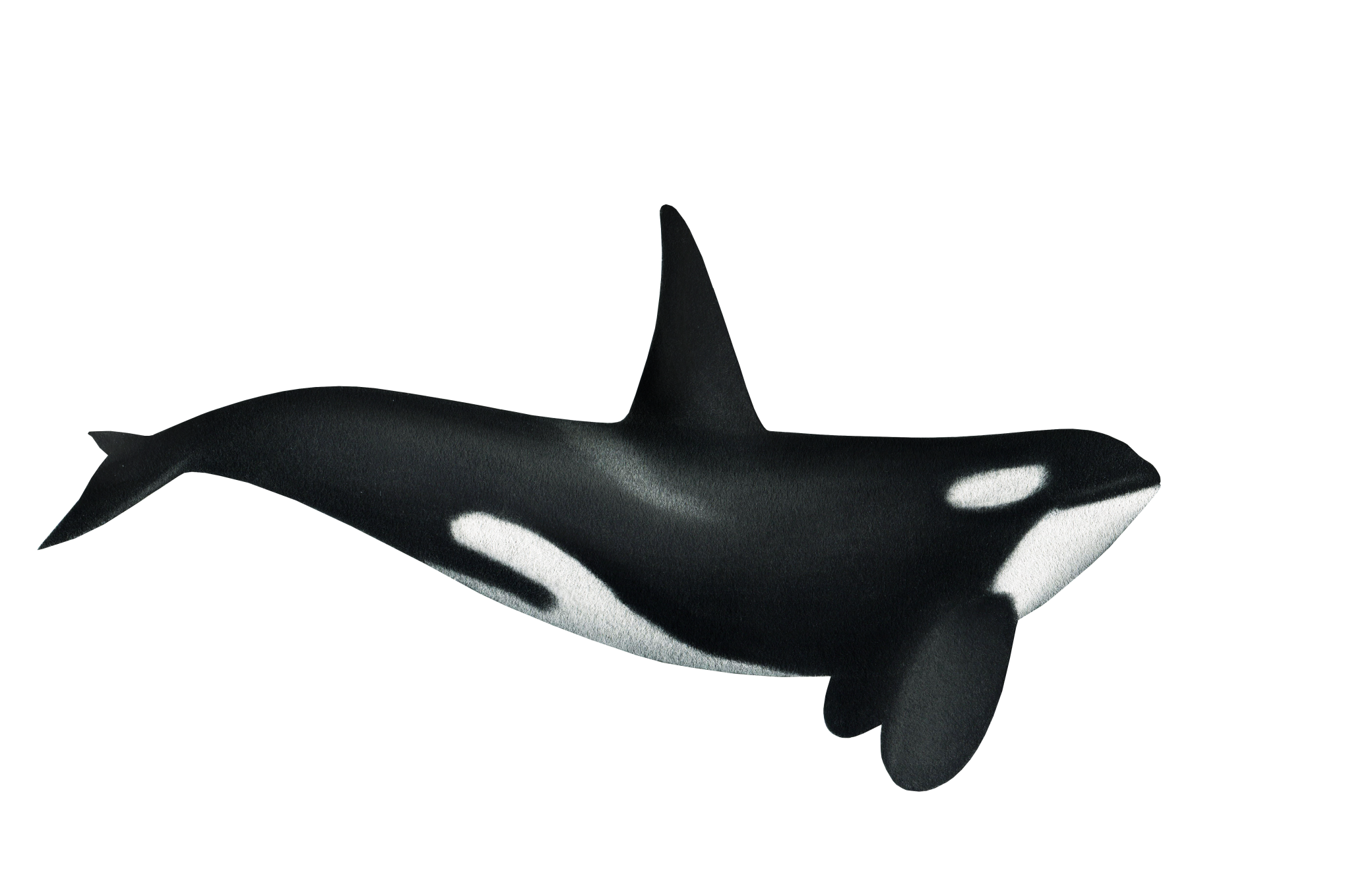
KILLER WHALE (ORCA)
Orcinus orca
SIZE: Male- 6.3m, Female- 5.9m
The orca, or killer whale (the name is interchangeable) is the top predator in the ocean. In some areas they eat large whales and even great-white sharks. However, in west Iceland they mostly feed on fish, predominantly herring. However some of the orcas we see in Iceland move to Scotland for part of the year where they feed on seals and mammals. The north-Atlantic killer whales do not fit into the ‘resident’ or ‘transient’ groupings that have been made for those in the Pacific north-west. Some groups are thought to stay in Iceland waters all year-round following herring.
Orcas are toothed whales. They live in relatively stable family groups that are run by a matriarch. Sons generally stay with their mother their whole life, unusual in the animal kingdom. Adult males can be seen clearly by their huge dorsal fin, up to 2m tall. It is this fin on the back as well as the grey saddle patch behind that we use to identify individual orcas and learn more about them.
Orcas are highly intelligent, have complex vocalisations and are known to have culture, with different eco-types around the world having different prey, vocal repertoire and traditions.
Láki Tours is the only whale watching company in Iceland that sees orcas regularly. They are present in the winter, when the herring is in the fjord. The best time to try and see them is between March and June, where we see them on the majority of tours, but of course not every day.
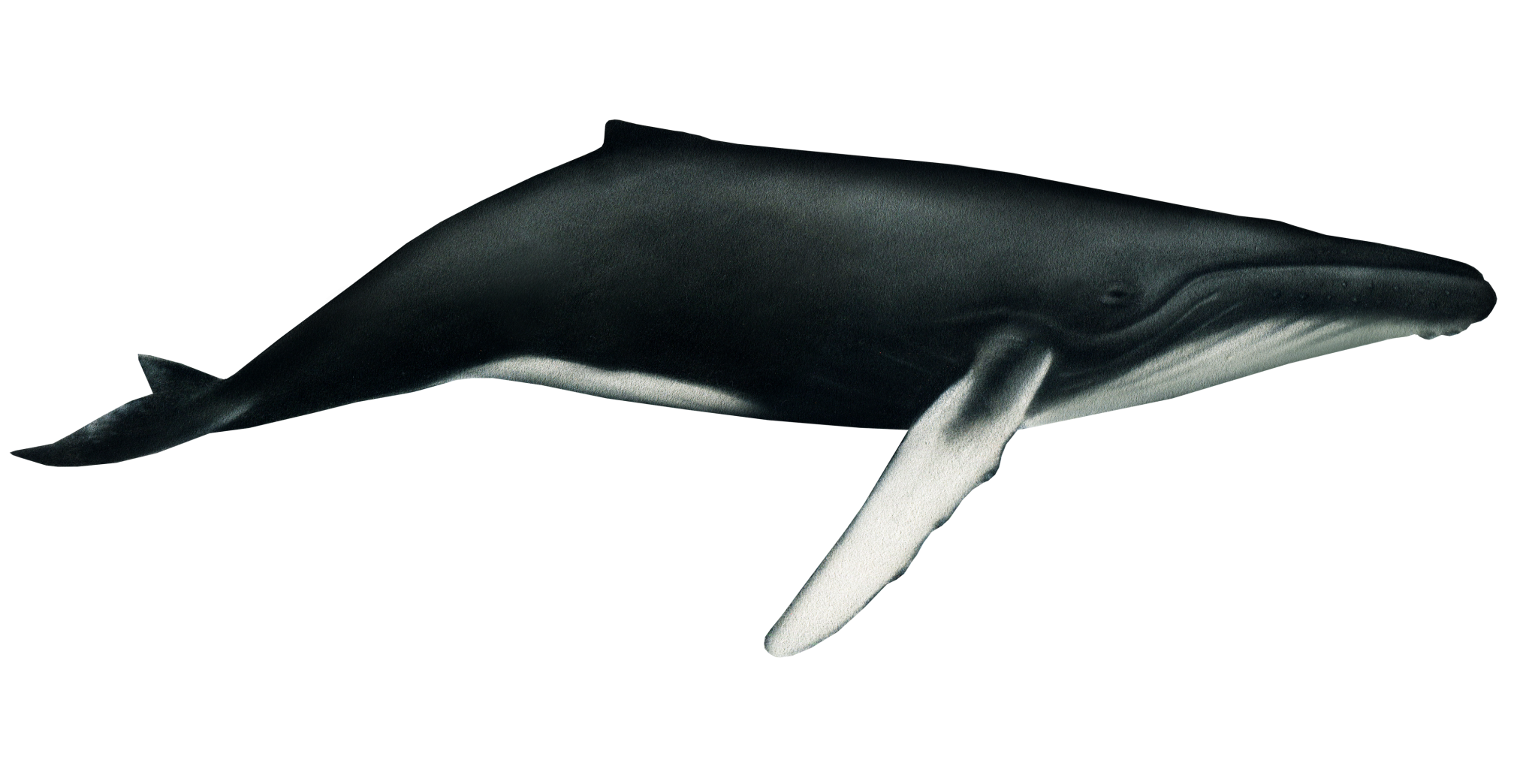
HUMPBACK WHALE
Megaptera novaeangliae
SIZE: Male 11-15m, Female 12-16m
The humpback whale is probably the most watched species of whale and a favourite, because they are the whale that jumps out of the water more than any other species. They also perform other surface activity, such as pec-slapping, spy-hopping, lob-tailing and tail throws.
Humpback whales come to Iceland to feed. They are a species of baleen whale, or filter feeding whale. Using the plates in their mouth they filter the water for small schooling fish and plankton. Here in Iceland they are known to eat krill, herring, mackerel, sand eels and capelin. During the winter months most humpbacks go south to warm water where they mate and give birth to their calves. When there they fast as there is little food for them, meaning a female who gives birth to a calf looses around a third of her body weight after giving birth and nursing her calf, before she can get back north to the feeding grounds.
Humpbacks are also famous for having culture. They sing long, complex songs. It is only the males who sing, mostly in the breeding grounds. Each breeding ground has a song that all the males there sing, but over time the song gradually changes. The whole population somehow alters the song, copying from one another. Exactly how this works we are not sure and we are still not sure exactly why they sing these amazing songs as they don’t appear to directly attract females. Males will still fight each other for access to a female.
Humpbacks also have complex feeding styles, more so than any other baleen whale. Sometimes they blow bubbles in a circle to trap the fish inside, called bubble-net feeding. We do not see this behaviour often in Iceland but it has been seen.
Láki Tours sees humpbacks in both fjords we work in, but they are the main species seen in summer from our boat in Hólmavík, Westfjords. This sheltered fjord is one of few places in the world you can watch humpbacks without multiple whale watching boats around.
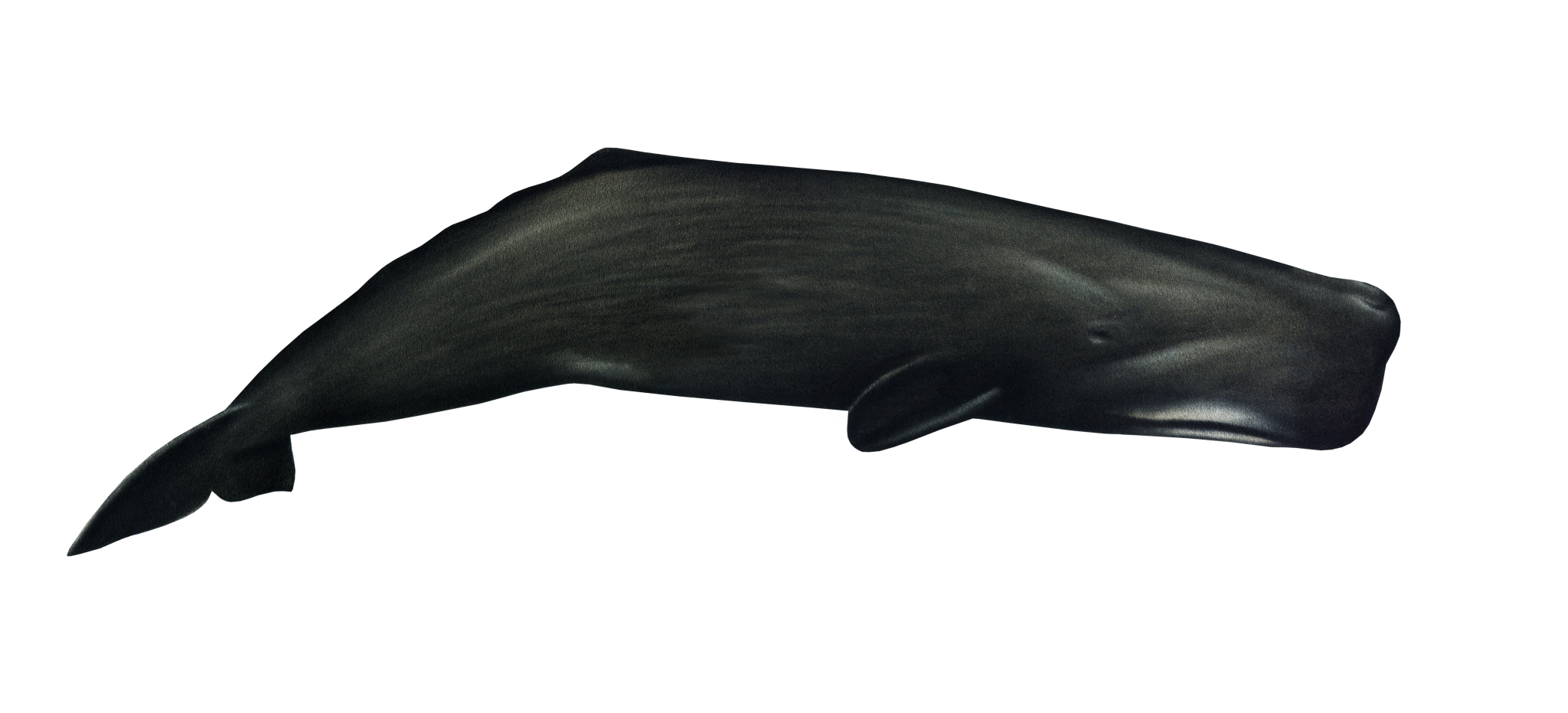
SPERM WHALE
Physeter macrocephalus
SIZE: Male- 14-16.5m, Female- 10.5-12m (though females not seen off Iceland)
The sperm whale is the largest toothed whale and considered the largest predator in the ocean. There are many amazing facts about sperm whales, their ability to dive to great depth (over 2km), hold their breath for up to 2 hours and their huge brains. They are also the only whale species to have wrinkled skin, but the reason why is still a mystery.
There is large sexual dimorphism in sperm whales, the males being up to 40% larger than the females. In Iceland we only see the males. The females with calves and juveniles live in warmer water in places like the Azores. Sperm whales are very wide-spread around the world but are not seen from whale watching boats so much because they live in very deep water, which tends to be too far offshore for whale watching.
Sperm whales also have culture. The females live together in tight-knit family units their whole lives. They make click sounds inside the huge nose that makes up almost a third of their body. These are used as eco-location when diving for food, but also to make ‘codas’. Codas are series of clicks in different patterns, which are unique to different family groups and clans of sperm whales. Two clans can live in the same area, but almost never socialise, only meeting up with families that make the same coda sequence as they do.
Once a male, born in the warm water, reaches around 8 years of age, he will leave his mother and her group, usually with other juvenile makes. They head for cold water, where there is more food. There they will feed until they reach sexual maturity around 20 years of age. Once sexually mature males will split their time between visiting the females in the warm water and feeding in the polar seas.
We are the only whale watch in Iceland to see sperm whales regularly. They are out in the deep part of the fjord and generally seen in the spring and early summer. It is always weather dependent to get out to them, but it is a very special privilege to see these gentle giants which were heavily hunted in the whaling days for their oil.
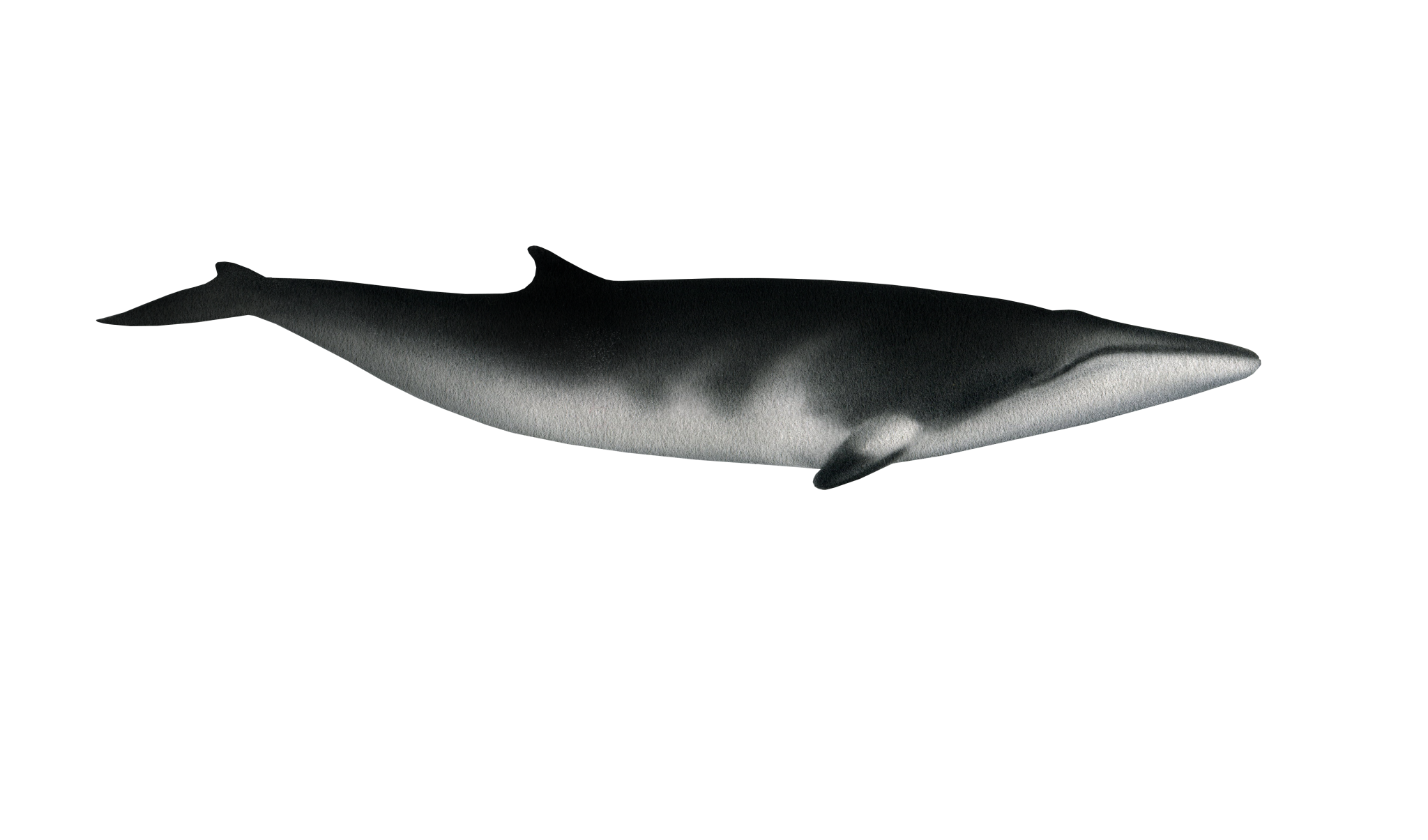
MINKE WHALE
Balaenoptera acutorostrata
SIZE: Male- 7.5-8.5m, Female- 8.5-9.5m
The Minke whale is a small species of baleen or filter feeding whale, found all around Iceland.
Generally solitary Minke whales come to Icelandic waters to feed, going south to warmer water in the winter to breed. We know relatively little about Minke whales and exactly where they spend winter is unclear. Calves are also very rarely ever seen.
Minke whales feed on schooling fish like herring and mackerel as well as plankton and krill.
Minke whales can be elusive and hard to watch. They are fast and streamlined and surface quickly. However, like many whales they sometimes get curious around boats.
Minke whales can be seen at any time of year from both our boats.
Minke whaling is still legal in Iceland, though none have been hunted for the last few years. We ask you please DO NOT eat Minke whale meat when you are in Iceland. It is being imported from Norway and is not generally eaten by Icelanders. The tourist industry is keeping this industry going. ‘Meet us, don’t eat us’.

BLUE WHALE
Balaenoptera musculus
SIZE: Male- 23-26m, Female- 24-27m
Blue whales are the largest animals that have ever lived on Earth as far as we know. Although not reaching the enormous sizes they did pre-whaling, in the north Atlantic they now average about 25-26m in length. The largest blue whales used to live in the southern ocean around Antarctica but were so heavily hunted during the industrial 20th century whaling, their numbers are still very low. The species as a whole is still considered endangered (critically endangered in the Antarctic). Estimates are around 5000-15,000 mature individuals are alive globally, whereas it is thought over 300,000 blue whales lived before whaling.
Again, like other baleen whales, blues migrate south in winter to breed. Exactly where is still unknown.
Only a small number of blue whales lift their tail when diving.
With an estimated population of just a few thousand in the North Atlantic it is always a great privilege to see a blue whale. They are not a regular sighting in either of the fjords we operate in, but can be seen in both. Blue whales mostly feed on krill and when a krill-bloom occurs in the fjord, which is very unpredictable, blue whales often show up. How they know there is food there for them is still a mystery. Olafsvik used to be the best place in Europe to see blue whales in the past, but the whales appear to have left the area they used to feed in regularly. It is thought they are generally moving north as the climate changes.

FIN WHALE
Balaenoptera physalus
SIZE: Male- 18-22m, Female- 20-23m
The second largest of the whales, the fin whale used to be called the ‘greyhound’ of the sea. They are incredibly fast and beautifully streamlined whales. Another one of the filter feeding whales, fin whales mostly feed further out to sea off Iceland and are not seen often but have been documented in both the fjords we whale watch in. Feeding on small schooling fish and plankton, like the other baleen whales, fin whales seem to be seen most often close to shore when the capelin (a small fish) comes in to breed in spring. Like the other baleen whales fin whales also go south in winter to breed.

SEI WHALE
Balaenoptera borealis
SIZE: Male- 12-15m, Female- 13-16m
Very similar to the fin whale the sei whale is a little studied whale species. They are a little smaller than fin whales and have a taller dorsal fin. Like all the other baleen whales they are mostly seen in summer where they also feed on small schooling fish and plankton which they filter through their baleen plates.
Sei whales are fairly rare visitors to the fjords around Iceland but have been seen a number of times from our boat in Breidafjördur. Like most of the large whales they were heavily hunted once whalers developed motor boats and exploding harpoons (before that these whales were too fast for the whalers). Sei whales are still considered endangered by the IUCN.

LONG-FINNED PILOT WHALE
Globicephala melas
SIZE: Male- 4-6.7m, Female- 3.8-5.7m
Long-finned pilot whales are a species of toothed whale, closely related to orcas. Like orcas they live in quite stable family groups that are run by an adult female, or matriach. Average group size is around 11-14 individuals, but long-finned pilot whales are very social, and can often be seen in groups numbering hundreds of individuals. This is many families together.
Males are larger than females, like all the toothed whales, and have a very rounded dorsal fin. Long-finned pilot whales can dive deeply and feed on squid and deep living fish. In Iceland they are probably feeding on mackerel and possibly cod down at depth, but we are not completely sure.
Like orcas too, long-finned pilot whale females are known to go through the menopause and live very complex, highly social lives, passing on vital information to younger generations in the group.
Long-finned pilot whales were a very regular sighting for many years in both the fjords we operate in but in particular off Ólafsvík in late summer and autumn, where groups of hundreds were a frequent and amazing sight. In the last couple of years sightings have declined somewhat and we are not sure why this is. They can be very curious and we could often turn off the engines of the boat and just drift, surrounded by whales which would spy-hop and sometimes blow bubbles and squeak at us next to the boat.
Long-finned pilot whales are sadly still hunted in the North Atlantic in the Faeroe Islands and it is not clear if these would be individuals we would sometimes be watching off west Iceland.
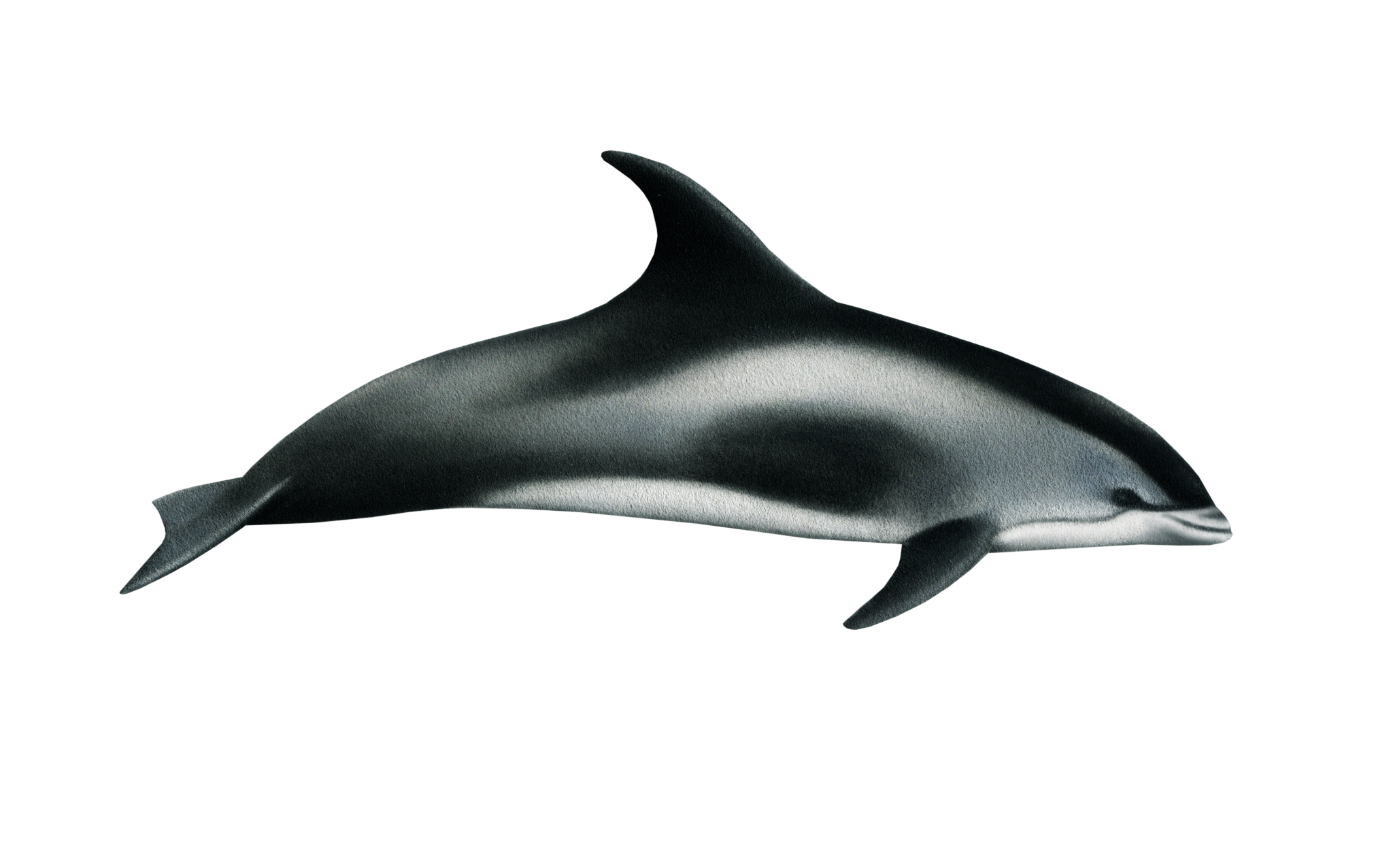
WHITE-BEAKED DOLPHIN
Lagenorhynchus albirostris
SIZE: 2.4 – 3.1m
The only species of dolphin seen around Iceland generally (unless you include the orca) is the white-beaked dolphin. They are a robust cold-water species only found in the North Atlantic.
White-beaked dolphins can be seen all year round in Iceland in groups from just 2 or 3 individuals, to hundreds. They are often associated with long-finned pilot whales in Breiðafjörður.
White-beaked dolphins can be very active, sometimes leaping high out of the water repeatedly. They are also known to ride the bow wave of boats, sometimes delighting us with their presence as they take it in turns to be at the front, pushed along by the wave the boat creates or surfing the waves at the back of the boat.
They feed on different kinds of fish, such as cod, haddock and capelin.
Like other toothed whales, white-beaked dolphins live in family groups and can mate and breed all year-round. They can be seen at any time of year from both our whale watching boats and also sometimes on puffin tours.
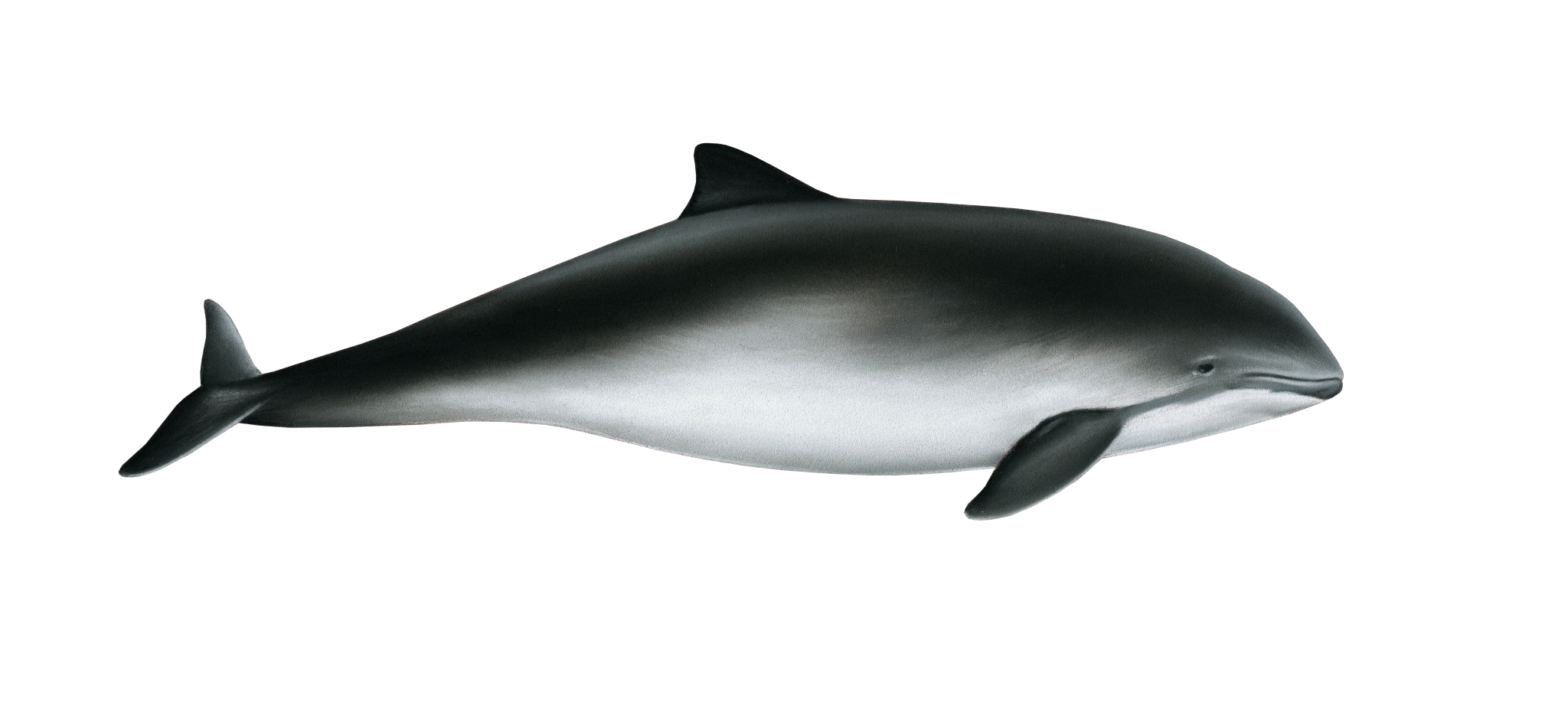
HARBOUR PORPOISE
Phocoena phocoena
SIZE: Male- 1.2-1.8m, Female- 1.5-1.9m
The shy, small harbour porpoise is probably around much more often than we actually see it. They do not like boats and due to their size can usually only be seen when the weather is very calm.
Porpoises are distinct from dolphins as they have different shaped teeth (square, instead of conical). There are only 7 species of porpoise found around the world and the harbour porpoise is the only porpoise in the North Atlantic.
Porpoises include the rarest of all cetaceans, the vaquita porpoise which is almost extinct with only around 10 individuals left. Porpoises often live close to shore and are very susceptible to being entangled in fishing gear and dying in the nets. This is probably the greatest threat to harbour porpoises around Iceland.
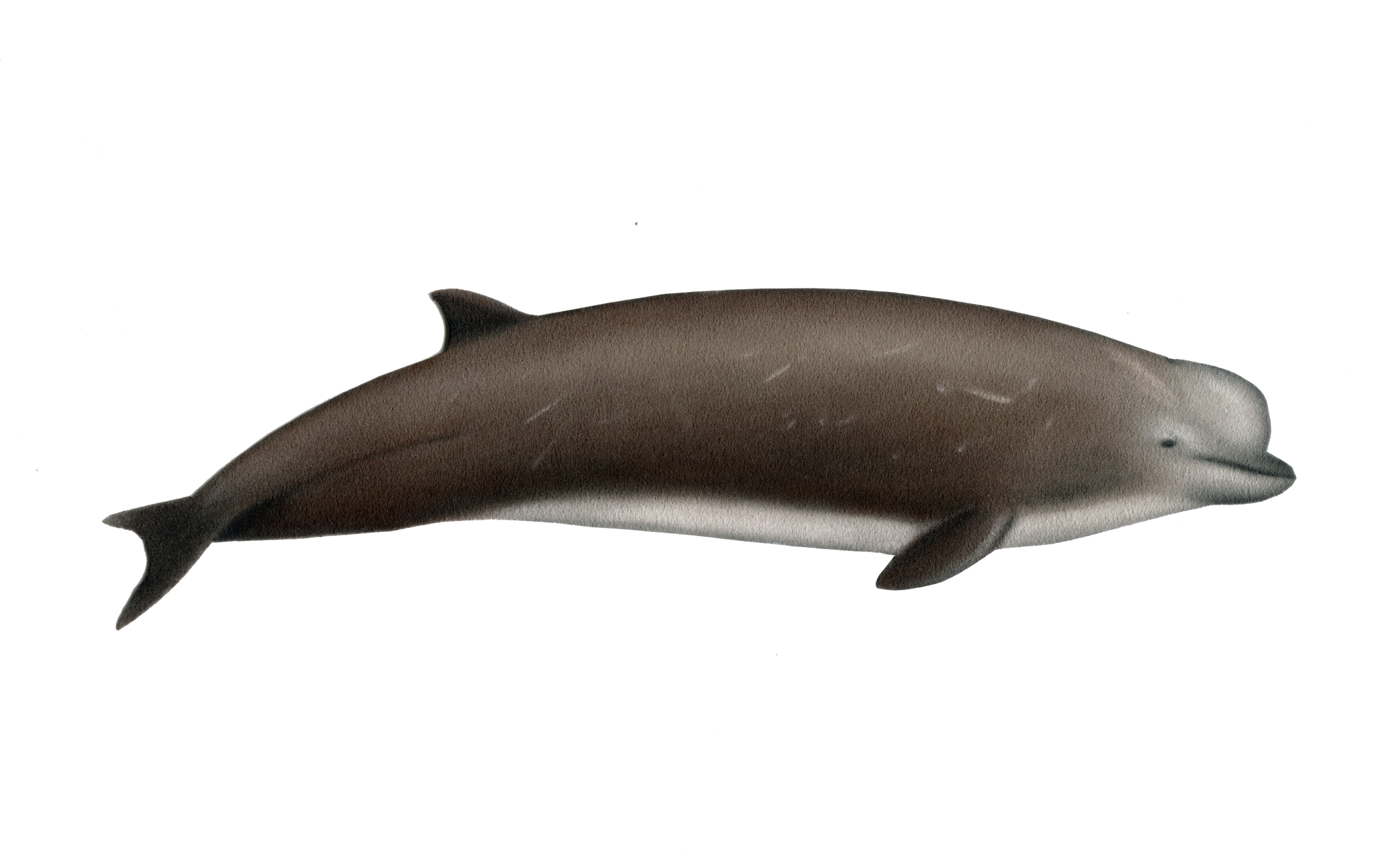
NORTHERN BOTTLENOSE WHALE
Hyperoodon ampullatus
SIZE: Male- 7.5-9m, Female- 7-8.5m
The northern-bottlenose whale is a very rare sight, but has been seen from both our whale watching boats in Ólafsvík and Hólmavík.
Little is known about them around Iceland and they can be prone to stranding on beaches. They are a type of beaked whale, which includes many of the least known and least studied whales in the world with some species only known from dead individuals. They are deep-diving whales and feed on deep living fish and squid.
As another species of toothed whale, they live in family groups, travelling and feeding together.
Northern bottlenose whales tend to be elusive around boats and are rarely sighted. One became very famous when is swam up the Thames river in London.
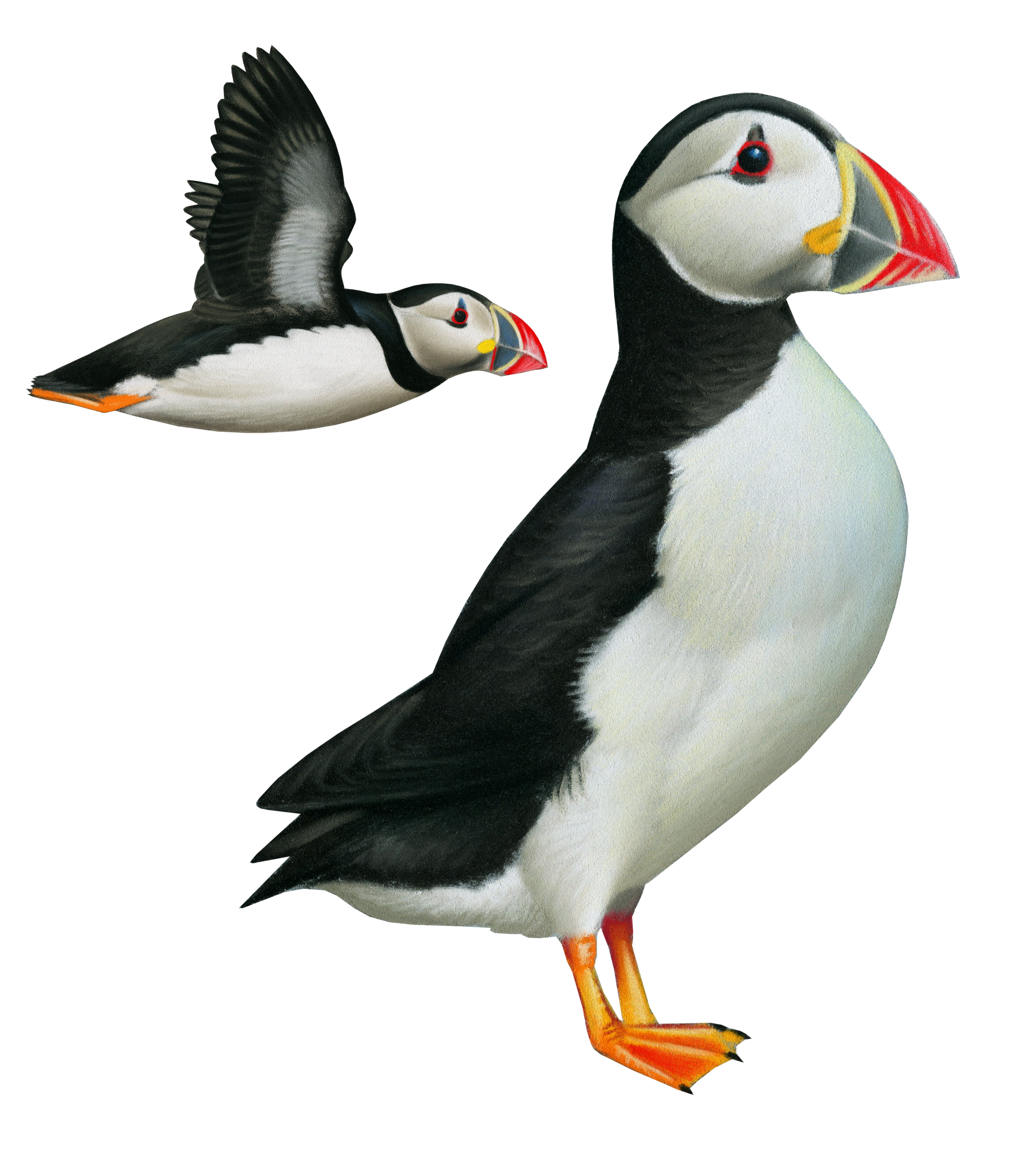
ATLANTIC PUFFIN
We are aware that puffins are not whales, but since puffins can often be seen on our whale watching tours, we have added them with this beautiful illustration by Dawid Kilon. They arrive in Iceland around April time, after spending the winter out in open ocean in the North Atlantic, feeding and surviving in the crazy storms of winter. In April and May they start to return close to land to look for their mate and begin the breeding season. Puffins mostly mate for life but do not spend all winter with their mate. They return to the same place to breed each year, spending the summer rearing one puffling. Once their egg has hatched we start to see the puffins holding fish in their mouth. They only do this to feed the chick, growing special hooks in their beak each year so they can carry food. In the winter they have no need for these hooks and they disappear, along with part of the beak and most of the colour. In winter puffins are much duller in colour, mostly grey without the beautiful orange on the beak and feet and their yellow rosette.
It is vital for the parents to feed the young chick enough during the short time it is in the nest. In recent years some Atlantic puffin colonies have declined a lot, in part due to lack of food close to land where they need it, in order to raise a healthy chick.
Please do not encourage puffin hunting when you are in Iceland by eating the meat. Puffins are now considered vulnerable by the IUCN and we would like to see an end to puffin hunting in Iceland, even though it is a tradition going back many years.
All drawings copyright Dawid Kilon.
We thank him for his kind permission to let us use them.
Please note all these species have been seen from our boats over the years but some are very rare to see. We are working with nature and so we never know what might be seen on each tour, though we have some regular visitors and some rare ones. All whales, dolphins and porpoises are in Iceland to feed so sightings generally depend on food availability.